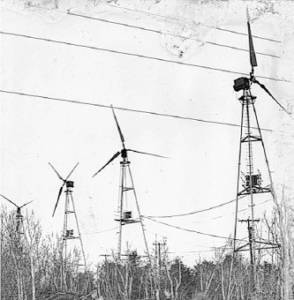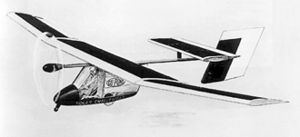1980
- The National Energy Education Development (NEED) Project begins on March 21, 1980 as a one-day celebration as a Joint Congressional Resolution recognizes National Energy Education Day. In the same year, President Jimmy Carter issues a Presidential Proclamation stressing the need for comprehensive energy education in our schools, a reduction in our dependence of fossil fuels, and increasing energy efficiency and the use of renewable energy technologies. (NEED)
- For the first time in the U.S., nuclear energy generates more electricity than oil. (DOE)
- U.S. Windpower installs the world’s first wind farm on the shoulder of Crotched Mountain, New Hampshire. The wind farm has 20 turbines and a total generating capacity of 600 kW. (AWEA)

Photo courtesy Crotched Mountain Rehabilitation Center.
1981
- The U.S. government ends price controls on crude oil and petroleum products. Supply and demand now set domestic crude prices. (DOE)
- The first large wind projects are built in Altamont Pass and Tehachapi, California by multiple wind energy developers. At this time, little is known about siting practices, and the interaction between wind and wildlife is poorly understood. (AWEA)
- Paul MacCready builds the first solar-powered aircraft—the Solar Challenger—and flies it from France to England across the English Channel. The aircraft has over 16,000 solar cells mounted on its wings, producing 3,000 watts of power. (EERE)

A drawing of the solar challenger.
1982
- The first photovoltaic megawatt-scale power station goes on-line in Hesperia, California. It is a 1-megawatt capacity system. (EERE)
- The U.S. Department of Energy, along with an industry consortium, begins operating Solar One, a 10-megawatt central-receiver demonstration project in California. The project establishes the feasibility of power-tower systems, a solar-thermal electric or concentrating solar power technology. The demonstration project runs until 1988. (EERE)
- The first (biomass) wood-fired power plant built primarily to generate electricity, begins operating in Vermont. (DOE)

The New York Times Archives.
1984
- Nuclear replaces hydropower as the second-largest source of electricity in the United States, after coal. (DOE)
1985
- New cars and light trucks are required to meet a Corporate Average Fuel Economy (CAFE) Standard for fuel economy of 27.5 miles per gallon. (DOE)
- The Clean Coal Technology Act passes. (DOE)
1986
- OPEC lowers the price of crude oil for the first time, by increasing production. Oil consumption grows quickly while prices remain low. (DOE)
- Chernobyl nuclear power plant accident occurs in the former USSR (now Ukraine). (DOE)
- The world’s largest solar thermal facility is built in Kramer Junction, California. The solar field contains rows of mirrors that concentrate the sun’s energy onto a system of pipes circulating a heat transfer fluid. The heat transfer fluid is used to produce steam, which powers a conventional turbine to generate electricity. (EERE)
1989
- The Exxon Valdez oil tanker runs aground, spilling 240,000 barrels of crude oil in Alaska’s Prince William Sound. (DOE)
Posted in Uncategorized
